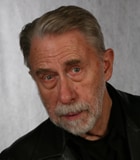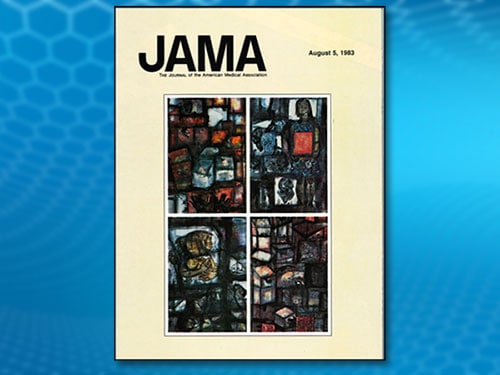
George D. Lundberg, MD
On August 6, 1945, the United States destroyed Hiroshima, Japan, with the first atomic bomb ever used in war. The second destroyed Nagasaki on August 9, 1945. The Hiroshima bomb ended WWII with Japan. Nagasaki resulted from faulty communication. No nuclear explosion in warfare has occurred since then, in no small part due to health professionals' delivery of this truth: There is no adequate medical response to nuclear war.
On August 5, 1983, JAMA published the first (of what became annual for many years) Hiroshima theme issue dedicated specifically to preventing nuclear war.
That initial issue included an original description by Japanese author Dr Taro Takemi about how he diagnosed the atomic bomb and informed the emperor, who, after consultation, ended the war.
The annual JAMA Hiroshima issue cover was original art of the Marukis, who visited Hiroshima soon after the blast and painted what they saw. We discovered their remarkable work at their gallery near Tokyo in 1983.

JAMA cover
Concurrent efforts by the International Physicians for the Prevention of Nuclear War, especially that of its founders, American cardiologist Bernard Lown and Russian cardiologist Yevgeniy Chazov, earned the Nobel Peace Prize in 1985.
This August 2023, medical journal editors the world over continue this tradition of joint massive publication to preserve our planet and its inhabitants.
Just as freedom is never free, peace must be earned. Health professionals of the world: Demand of the political leaders of all countries that there be NO NUCLEAR WAR.
Here is the text of this year's statement in JAMA Network Open:
Reducing the Risks of Nuclear War—The Role of Health Professionals
Abbasi; Parveen Ali; Virginia Barbour; Kirsten Bibbins-Domingo; Marcel G.M. Olde Rikkert; Andy Haines; Ira Helfand; Richard Horton; Bob Mash; Arun Mitra; Carlos Monteiro; Elena N. Naumova; Eric J. Rubin; Tilman Ruff; Peush Sahni; James Tumwine; Paul Yonga; Chris Zielinski
In January 2023, the Science and Security Board of the Bulletin of the Atomic Scientists moved the hands of the Doomsday Clock forward to 90 seconds before midnight, reflecting the growing risk of nuclear war.1 In August 2022, the UN Secretary-General António Guterres warned that the world is now in "a time of nuclear danger not seen since the height of the Cold War."2 The danger has been underlined by growing tensions between many nuclear armed states.1,3
As editors of health and medical journals worldwide, we call on health professionals to alert the public and our leaders to this major danger to public health and the essential life support systems of the planet—and urge action to prevent it. Current nuclear arms control and nonproliferation efforts are inadequate to protect the world's population against the threat of nuclear war by design, error, or miscalculation. The Treaty on the Non-Proliferation of Nuclear Weapons (NPT) commits each of the 190 participating nations "to pursue negotiations in good faith on effective measures relating to cessation of the nuclear arms race at an early date and to nuclear disarmament, and on a treaty on general and complete disarmament under strict and effective international control."4
Progress has been disappointingly slow and the most recent NPT review conference in 2022 ended without an agreed statement.5
There are many examples of near disasters that have exposed the risks of depending on nuclear deterrence for the indefinite future.6 Modernization of nuclear arsenals could increase risks: for example, hypersonic missiles decrease the time available to distinguish between an attack and a false alarm, increasing the likelihood of rapid escalation. Any use of nuclear weapons would be catastrophic for humanity. Even a "limited" nuclear war involving only 250 of the 13,000 nuclear weapons in the world could kill 120 million people outright and cause global climate disruption leading to a nuclear famine, putting 2 billion people at risk.7,8 A large-scale nuclear war between the US and Russia could kill 200 million people or more in the near term, and potentially cause a global "nuclear winter" that could kill 5 to 6 billion people, threatening the survival of humanity.7,8 Once a nuclear weapon is detonated, escalation to all-out nuclear war could occur rapidly.
The prevention of any use of nuclear weapons is therefore an urgent public health priority and fundamental steps must also be taken to address the root cause of the problem—by abolishing nuclear weapons. The health community has had a crucial role in efforts to reduce the risk of nuclear war and must continue to do so in the future.9 In the 1980s the efforts of health professionals, led by the International Physicians for the Prevention of Nuclear War (IPPNW), helped to end the Cold War arms race by educating policy makers and the public on both sides of the Iron Curtain about the medical consequences of nuclear war. This was recognized when the 1985 Nobel Peace Prize was awarded to the IPPNW.10
In 2007, the IPPNW launched the International Campaign to Abolish Nuclear Weapons, which grew into a global civil society campaign with hundreds of partner organizations. A pathway to nuclear abolition was created with the adoption of the Treaty on the Prohibition of Nuclear Weapons in 2017, for which the International Campaign to Abolish Nuclear Weapons was awarded the 2017 Nobel Peace Prize. International medical organizations, including the International Committee of the Red Cross, the IPPNW, the World Medical Association, the World Federation of Public Health Associations, and the International Council of Nurses, had key roles in the process leading up to the negotiations, and in the negotiations themselves, presenting the scientific evidence about the catastrophic health and environmental consequences of nuclear weapons and nuclear war. They continued this important collaboration during the First Meeting of the States Parties to the Treaty on the Prohibition of Nuclear Weapons, which currently has 92 signatories, including 68 member states.11
We now call on health professional associations to inform their members worldwide about the threat to human survival and to join with the IPPNW to support efforts to reduce the near-term risks of nuclear war, including 3 immediate steps on the part of nuclear-armed states and their allies: first, adopt a no first use policy12; second, take their nuclear weapons off hair-trigger alert; and third, urge all states involved in current conflicts to pledge publicly and unequivocally that they will not use nuclear weapons in these conflicts. We further ask them to work for a definitive end to the nuclear threat by supporting the urgent commencement of negotiations among the nuclear-armed states for a verifiable, timebound agreement to eliminate their nuclear weapons in accordance with commitments in the NPT, opening the way for all nations to join the Treaty on the Prohibition of Nuclear Weapons.
The danger is great and growing. The nuclear armed states must eliminate their nuclear arsenals before they eliminate us. The health community played a decisive part during the Cold War and more recently in the development of the Treaty on the Prohibition of Nuclear Weapons. We must take up this challenge again as an urgent priority, working with renewed energy to reduce the risks of nuclear war and to eliminate nuclear weapons.
References
Science and Security Board, Bulletin of the Atomic Scientists. A time of unprecedented danger: it is 90 seconds to midnight. 2023 Doomsday Clock Statement. January 24, 2023. Accessed June 1, 2023. https://thebulletin.org/doomsday-clock/current-time/
United Nations. Future generations counting on our commitment to step back from abyss, lift cloud of nuclear annihilation for good, secretary-general tells review conference. Press release SG/SM/21394. August 1, 2022. Accessed July 10, 2023. https://press.un.org/en/2022/sgsm21394.doc.htm
Tollefson J. Is nuclear war more likely after Russia's suspension of the New START treaty? Nature. 2023;615 (7952):386. doi:10.1038/d41586-023-00679-w
United Nations. Review Conference of the Parties to the Treaty on the Non-Proliferation of Nuclear Weapons (NPT). May 2-27, 2005. Accessed June 2, 2023. https://www.un.org/en/conf/npt/2005/npttreaty.html
Mukhatzhanova G. 10th NPT Review Conference: why it was doomed and how it almost succeeded. Arms Control Association. October 2022. Accessed June 2, 2023. https://www.armscontrol.org/act/2022-10/features/10th-npt-review-conference-why-doomed-almost-succeeded
Lewis P, Pelopidas B, Williams H. Too close for comfort, cases of near nuclear use and options for policy. Chatham House Report. April 2014. Accessed June 1, 2023. https://www.chathamhouse.org/2014/04/too-closecomfort-cases-near-nuclear-use-and-options-policy
Bivens M. Nuclear famine. IPPNW. August 2022. Accessed June 1, 2023. https://www.ippnw.org/wp-content/uploads/2022/09/ENGLISH-Nuclear-Famine-Report-Final-bleed-marks.pdf
Xia L, Robock A, Scherrer K, et al. Global food insecurity and famine from reduced crop, marine fishery and livestock production due to climate disruption from nuclear war soot injection. Nat Food. 2022;3(8):586-596. doi: 10.1038/s43016-022-00573-0
Helfand I, Lewis P, Haines A. Reducing the risks of nuclear war to humanity. Lancet. 2022;399(10330): 1097-1098. doi:10.1016/S0140-6736(22)00422-6
The Nobel Prize. International Physicians for the Prevention of Nuclear War—facts. 1985. Accessed June 1, 2023. https://www.nobelprize.org/prizes/peace/1985/physicians/facts/
UN Office for Disarmament Affairs. Treaties Database. Treaty on the Prohibition of Nuclear Weapons: status of the Treaty. January 2021. Accessed June 2, 2023. https://treaties.unoda.org/t/tpnw
Center for Arms Control and Non-Proliferation. No first use: frequently asked questions. Accessed June 2, 2023. https://armscontrolcenter.org/issues/no-first-use/no-first-use-frequently-asked-questions/
Follow Medscape on Facebook, X (formerly known as Twitter), Instagram, and YouTube
Credits:
Lead: Medscape Illustration: JAMA, Dreamstime
Headshot: George D. Lundberg, MD
Medscape Internal Medicine © 2023 WebMD, LLC
Any views expressed above are the author's own and do not necessarily reflect the views of WebMD or Medscape.
Cite this: Global Health Professionals Must Continue to Prevent Nuclear War - Medscape - Aug 28, 2023.








Comments